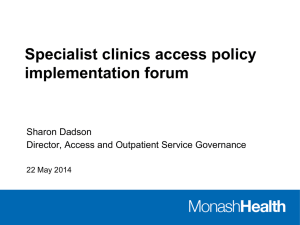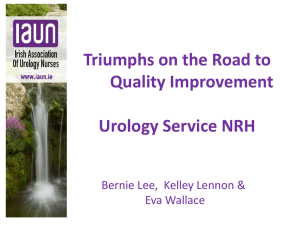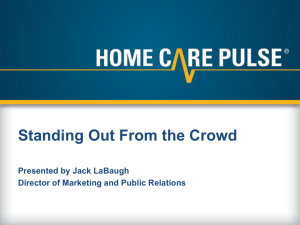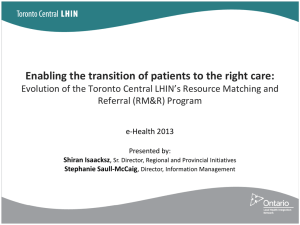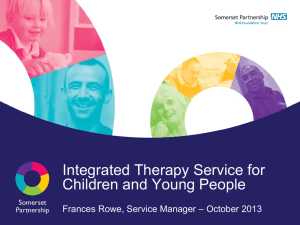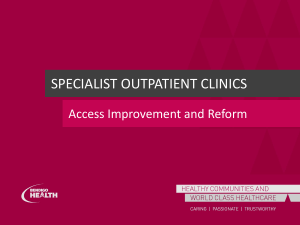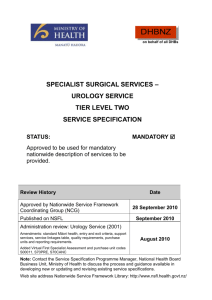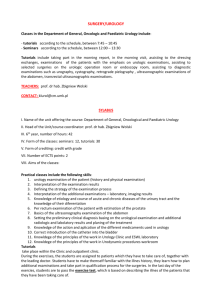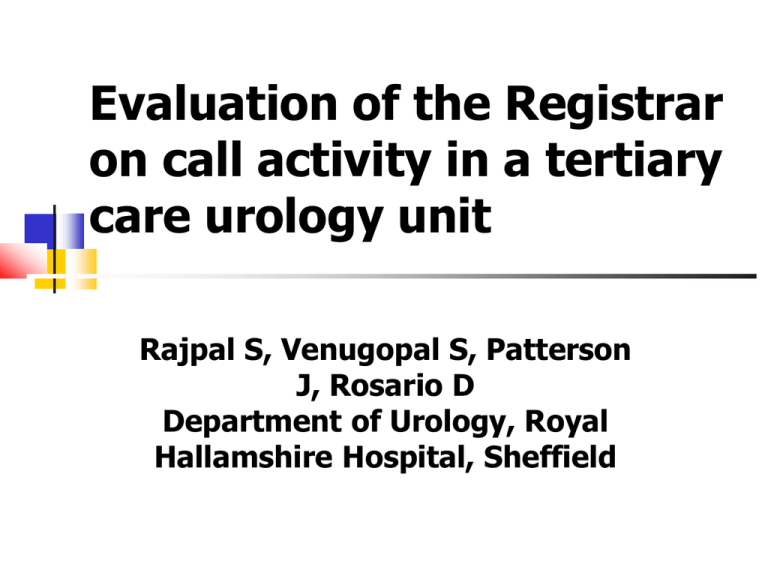
Evaluation of the Registrar
on call activity in a tertiary
care urology unit
Rajpal S, Venugopal S, Patterson
J, Rosario D
Department of Urology, Royal
Hallamshire Hospital, Sheffield
On call activity of urology registrar
Background:
With EWTD, no SHO for day oncall – calls directly to registrars
Can we optimise the types of calls and improve training time?
Materials and methods:
120 logged calls through were looked into for type of referral,
source of referral, appropriateness, level of input needed.
Urology Consultations: The Hidden Workload? http://dx.doi.org/10.1308/147363510X535250
On call activity of urology registrar
Results:
Though majority of the calls were appropriate (71%), they
were not emergency (only 19%) requiring on-call support.
Conclusion:
Development of online referral system
Red, amber and green referrals
Call the on call registrar for all the red referrals (acute
urological emergencies).
This will free up valuable training time for registrars
(new referrals generated through the amber and green
system are logged on the referral pathway - ££££!!!!)
Evaluation of the Registrar on call activity in a tertiary care urology unit
Rajpal S, Venugopal S, Patterson J, Rosario D
Department of Urology, Royal Hallamshire Hospital, Sheffield
Introduction
STH Department of Urology
Referral for Urgent Urology Advice or In-Patient Review
For EM ERGENCY Urology referrals please bleep 001
The implementation of the EWTD has resulted in
restructuring of hospital on call teams.
For ROUTINE Urology referrals please fax referral to 0114 2711755
use the mouse, and click the left mouse -button, or the k eyboard tab-k ey _____ to position the cursor
The urology day on call working pattern in our unit had to
be modified as a consequence.
First Name
Patient ID
Last Name
W ard
Date of Birth
Sex
Consultant
Age
UROLOGY PROBLEM
HISTORY
EXAMI NATI ON
We sought to assess the day time on call registrar activity
and categorise the type of referrals and sources. With the
information gained, we aim to change the referral process
ensuring a balance between good patient care and
optimal training opportunities.
Fig 1. Chart showing the source of referrals
INVESTI GATI ONS
W HAT DO YOU W ANT?
IN-PATIENT REVIEW
ADVICE
Your Name
Your Grade
STH Emai l
Phone
Bleep
Clear Referral
Make Referral
Exi t Referrals
Fig 4. Model template 1 of the online
referral system
Material and methods
ST H Department of U rology
Referral for U rgent U rology Advice or In -Patient R eview
All middle grades participating in the on call rota were
invited to complete an activity sheet prospectively.
The proforma included time of the referral, source,
urgency (emergency, urgent, routine), action taken and
whether the referrals were appropriate or not as judged
by the individual.
EMERGENCY
Fig 2. Clinical presentations of the referrals
SOON
ROUTINE
Contact Urology SpR oncall on bleep 2001 (RHH)
Refer via this system
for advice or review
Fax referral for OPA to
0114 2711755 (x11755)
e.g.
e.g.
OR
Trauma
Urinary retention
Testicular pain <40yo
Post-op retention (should
do ISC if possible)
Direct to GP for onward
referral if suitable
Obstructed soli tary kidney
e.g.
Ureteric colic
Infected obstructed kidney
Non- visible haematuria
Visible haematuria
Urinary tract obstruction
with new renal failure
Recurrent UTIs
Post-op wound infection
Priapism
Lower UT symptoms
Patient details:
Referrer Name:
Name:
DoB:
Hospital No:
Ward:
/
/
Cons:
Grade:
Tel Ext:
STH email:
Bleep:
@sth.nhs.uk
Urological Problem/Differential diagnosis:
History, Examination and Investigation findings:
Results
Request:
A total of 120 referrals were logged over a four month
period.
Fig 3. Appropriateness of the referrals
Calls from SHO level trainees formed the maximum
activity (31%), followed by general practitioners (19%)
and FY1’s (16%).
25% of the referrals were routine, 56% urgent and 19%
were emergencies.
Nearly one third (29%) of the referrals were deemed
inappropriate and were mainly from other specialities
within the hospital.
Advice
□
Referral
□
In-patient review
□
Fig 5. Model template 2 of the online
referral system
Conclusions
Our results show that nearly a third of the day on call activity included routine patients and patients whose care did not require
involvement of the on call registrar.
With the information available, we are developing an electronic referral (fig 4,5)system which could differentiate urgent from
routine referrals and ensure better use of valuable training time.



